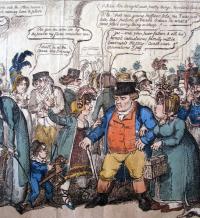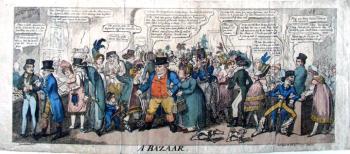
This is one of George Cruikshank’s earliest etchings. In it we find John Bull (who always personified the English public), along with his family, enjoying a day at the Soho Bazaar. Around them, a mob of fairly rakish buyers are working their way through the stalls.
According to our rare book friends at Marlborough, the Bazaar was established by John Trotter in 1815 to enable the widows and daughters of Army officers to dispose of their handiwork. Counter space was rented at 3d. per foot per day, with open counters arranged on both sides of aisles or passages, and on two separate floors of the building. This market was the first of its kind and extended from the north-west corner of Soho Square to Oxford Street.
The items sold at these stalls were almost exclusively something for the dress or personal decoration of ladies and children; such as millinery, lace, gloves, or jewelry. At the height of the season, the long line of carriages alongside the building testified to the number of wealthy visitors who enjoyed browsing through the merchandise.
Some of the rules of the establishment were very stringent. A plain, modest style of dress was required for the young, female workers and a matron was always on duty to check on this.
